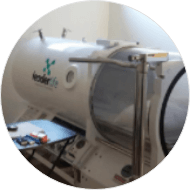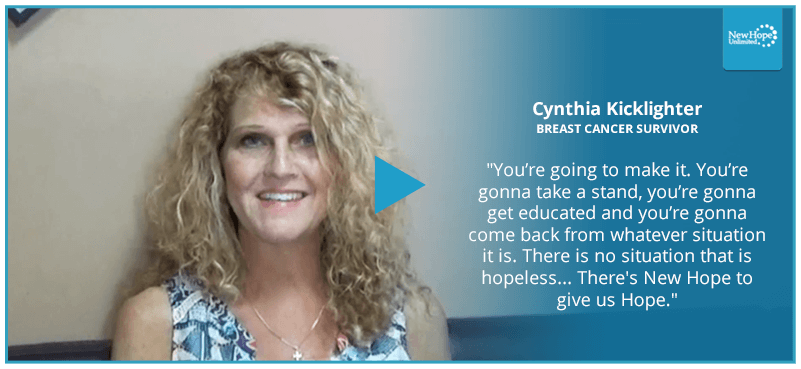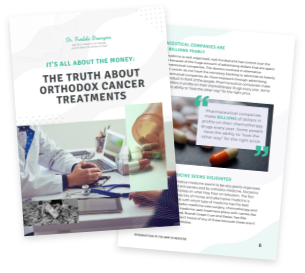Outstanding Cancer Treatment Results

Why Choose New Hope for Alternative Cancer Treatments
 Advanced Cancer Treatments
Advanced Cancer Treatments Top-Rated Physicians
Top-Rated Physicians Personal Care
Personal Care Patient Satisfaction
Patient SatisfactionWhat Is Breast Cancer?
Breast cancer is a persistent disease that starts when cells in the breast grow out of control, usually forming a mass (tumor). If the tumor is cancerous (malignant), the cells can invade surrounding tissues or spread (metastasize) to distant areas of the body. The most common sites are the skin around a lumpectomy or mastectomy scar, scalp, lymph nodes, bone, lung, liver, and brain. Currently, the average risk of a woman in the U.S. developing breast cancer is approximately 12%, meaning there is a 1 in 8 chance a woman will get breast cancer. Factually, despite popular belief, breast cancer also occurs in men, though it is more prevalent among women. Most patients with breast cancer diagnoses have likely had the cancerous mass for 5 to 10 years. Cancer of the breast is easily felt in the chest once they reach a size of approximately 1 cm. A lump of this size contains about one billion cells, which results from 30 doublings of a single cancer cell. Assuming that a breast lump grows with a doubling time of 100 days, it would take approximately ten years to reach a point where it could be felt.Types of Breast Cancer
Millions of people around the world are affected by breast cancer and its several types. Our team of physicians and researchers understand that breast cancers respond to treatment in different ways, meaning each cancer type and location is unique. Some of the most common kinds of breast cancer we treat include:Inflammatory Breast Cancer
This rare and aggressive disease blocks lymph vessels in the skin of the mammary gland, making the breasts appear swollen, red, and inflamed. The disease progresses within a matter of weeks or months. In fact, inflammatory breast cancer diagnoses are either stage III or IV diseases, depending on whether cancer cells have metastasized only to nearby lymph nodes or to other tissues.Ductal Carcinoma in Situ
st Ductal carcinoma in situ (DCIS) is non-invasive breast cancer. “Ductal” means that cancer begins inside the breast milk ducts; “carcinoma” refers to cancer that begins in the skin or other tissues that line the internal organs; “in situ” means “in its original place.” DCIS is not life-threatening, but having the disease can increase the risk of developing invasive breast cancer later on.Invasive Ductal Carcinoma
Invasive ductal carcinoma (IDC), otherwise known as infiltrating ductal carcinoma, is breast cancer that grows within the milk duct and invades the fatty tissue of the breast outside the duct. IDC is the most common type of breast cancer, representing 80 percent of all breast cancer diagnoses. Invasive ductal carcinoma may metastasize to other parts of the body if not treated.Invasive Lobular Carcinoma
Also beginning in the milk-producing glands (lobules) of the breast, invasive lobular carcinoma is responsible for approximately 10 to 15 percent of all breast cancer cases in the United States. Invasive cancer means the cancer cells are no longer confined in the lobule where they developed and can metastasize to nearby lymph nodes and other vulnerable areas of the body.Stages of Breast Cancer
Stage 0. At this stage, you are likely to hear the word “situ” meaning “in the original place.” There is no indication of cancer cells developing outside of the breast, nor are they invading neighboring healthy tissue.
Stage I. Starting at this level, breast cancer is called invasive because it has broken free to attack healthy tissue. Stage IA denotes cancer has spread into the fatty breast tissue. The tumor itself can be nonexistent or no larger than a shelled peanut. Stage IB indicates the presence of cancer cells in a few lymph nodes, but only in small amounts.
Stage II. At this stage. cancer has grown, spread, or both. Stage IIA means the tumor in the breast is quite small or nonexistent. There may be no cancer in the lymph nodes, or it may have spread to as many as three. A stage IIB breast tumor is more prominent and maybe as big as a lime. It may or may not be in any lymph nodes.
Stage III. In stage III breast cancer, the tumor is more than two inches in diameter. Though considered advanced and challenging to treat, cancer has not spread to the bones or organs. Stage IIIA means cancer has been found in at least nine of the lymph nodes, while IIIB suggests the tumor has developed into the skin around your breast, and IIIC implies cancer has been found in 10 or more lymph nodes.
Stage IV. At this crucial stage, cancer has metastasized to more distant areas of the body. The most common sites include the bones, lungs, liver, and brain. New Hope Unlimited’s treatment strategy for Stage IV breast cancer focuses on each cancer site to efficiently reduce symptoms and improve the patient’s quality of life during recovery.
Warning Signs or Symptoms
It is crucial to consult a physician when experiencing breast cancer symptoms, including:- a change in size or shape
- a lump or area that feels thicker than the rest of the breast
- a change in skin texture such as puckering or dimpling
- presence of unilateral, painful, pruritic, and/or burning lesions
- nipple discharge without squeezing
- redness or rash on the skin and/or around the nipple
- lymph node enlargement around the breast, armpit, or collarbone
- recurring pain in your breast or armpit
- the sudden warmth and itching sensation
Major Risk Factors
Today, the exact cause of breast cancer remains unknown, but some factors may affect a person’s risk of developing the disease, including:Lifestyle-related Breast Cancer Risk Factors
- Drinking alcohol. Studies consistently show that drinking alcoholic beverages increase a woman’s risk of hormone-receptor-positive breast cancer.
- Smoking tobacco. Smoking is linked to a higher risk of breast cancer in younger, premenopausal women.
- Being overweight or obese. This higher risk is because fat cells make estrogen, and estrogen can make hormone-receptor-positive breast cancers develop.
- Lack of exercise. 1.25 to 2.5 hours of brisk walking every week can reduce breast cancer risk by 18%.
- Late pregnancy. Women who bear their first child after age 30 have a slightly higher chance of developing breast cancer.
- Not breastfeeding. Some studies suggest that breastfeeding may lower breast cancer risk, especially if continued for up to 2 years.
- Birth control. The risk increase varies from 0% to 60%, depending on the specific type of oral combined hormone contraceptive.
- Radiation exposure. Women who were exposed to radiation treatment to the chest are at a higher risk for breast cancer.
Breast Cancer Risk Factors You Cannot Change
- Being a woman. Being born female makes you more prone to breast cancer as compared to males.
- Age. Most invasive cancer cases have been diagnosed in women aged 55 and older.
- Inherited genes. The BRCA1 and BRCA2 genes are inherited and account for about 3% of breast cancers.
- Family history. You may be two to three times more at risk if you have first-degree relatives who had breast cancer.
- Race.
- Personal history of breast cancer. Surviving breast cancer has an increased risk of getting cancer in the other breast.
- Early menstruation and late menopause. Menstruating before age 12 and experiencing menopause later than age 55 increases breast cancer risk due to longer exposure to estrogen.
- Breast density. Women with dense breasts are up to 2 times more likely to develop breast cancer than a woman with an average breast density.
Other breast cancer risk factors are requiring more in-depth investigation, such as diet and vitamins, chemical exposure, and working night shifts. Current findings are still inconclusive about their link with breast cancer.
Breast Cancer Diagnostic Process
Breast Exam
Though clinical breast exams are more effective (and necessary) to detect cancer, you can also perform a breast self-exam (BSE) at home. To locate abnormalities: Lay a pillow under your left shoulder and place your left arm behind your head. Using your right hand, move your fingers around your left breast gently in circular motions, covering the entire breast and armpit area. Use light, medium, and firm pressure. Squeeze the nipple to check for discharge and lumps. Do the same for your right breast.Mammogram
Mammography is the process of using low-energy x-ray to examine the human breast. It helps detect changes, abnormalities, or lumps that may take years before becoming apparent.Breast Ultrasound
Breast ultrasound is the best way to determine if an abnormality in the breast is a solid mass or a cyst that’s filled with fluid.Biopsy
A biopsy involves the extraction of sample cells or tissues for examination. It determines the presence or extent of cancer in the breast.Breast MRI
Breast MRI is another type of imaging test that generates a clear picture of any abnormalities inside the breast. A dye will be injected before the test.How the New Hope Medical Center Treats Breast Cancer
Our breast cancer treatment programs may include, but are not limited to:
Anti-Tumor Intravenous Therapy
IV therapy allows a high dose of vitamins, minerals, and antioxidants to enter the bloodstream without passing through the digestive tract.Dendritic Cell Therapy
Since the 1990s, dendritic cells are clinically used as cellular mediators for the therapeutic vaccination of patients with cancer and advanced diseases.Advanced Immunotherapy
Advanced immunotherapy boosts the body’s natural ability to combat cancer by restoring immune system function.Ozone Therapy
Ozone therapy is used to sterilize and treat conditions by disinfecting the area around them, improving the body’s absorption and use of oxygen, and stimulating the immune system.Hyperbaric Oxygen Therapy
Your body needs a sufficient supply of oxygen to function. Hyperbaric oxygen therapy is a well-established treatment that involves breathing pure oxygen in a pressurized tube or room.Ultraviolet Blood Irradiation Therapy (UBI)
UBI is a method that exposes the blood to light, which heightens the body’s immune response to eliminate infections.Far Infrared Therapy
Far infrared enhances circulation in the skin, eases pains, modulates sleep, protects against oxidative stress, and reduces inflammation.Nutritional Guidance and Lectures
Proper nutrition is essential to good health and is absolutely essential for a fully-functional and disease-combating body.Autologous Immunogen Therapy (AIT)
The feasibility and immunogenicity of an autologous AT-2-inactivated DC vaccine have been shown to support the potential use for therapeutic immunization of chronically infected individuals, including cancer patients.Facilities
At New Hope Unlimited, we pride ourselves in providing superior comfort, cleanliness, and cancer care at our 8,000 square foot medical treatment center in San Luis Rio Colorado, Mexico. We worked with renowned architects and contractors to create the ideal space for recovery, which includes state-of-the-art lounge areas and spacious private in-rooms that assure the comfort of our patients and their loved ones. To make our patients feel right at home, each private ward is equipped with high-definition U.S. television, quality bedding, and high-speed internet connection. And with proper nutrition playing a vital role in cancer recovery, New Hope Unlimited also fulfills the dietary needs of each patient using fresh, organic produce to prepare breakfasts, lunches, snacks, and dinners. Comfort and cleanliness are also strictly implemented in our medical treatment rooms, which are equipped with the latest technology and equipment to provide the highest standard of care and treatment. Our medical center also has an in-house Hyperbaric Chamber, a well-established therapy for decompression sickness, exclusively available for our patients’ use. Further, New Hope Unlimited has maintained its exceptional partnership with Hospital Migoo, a medical group comprised of certified physicians and specialists that are committed to our patients’ comfort and well-being.FAQs
1. How often should I do a breast self-exam (BSE)?It’s important to give yourself a breast self-exam once a month. If you discover a persistent lump or any changes in your breast, see a physician immediately. Though 8 out of 10 lumps are benign, they still require evaluation to confirm that they are not harmful.
2. Are mammograms painful?
Mammography compresses the breasts, which can cause slight discomfort for a brief period. If you are sensitive, schedule your mammograms a week after your menstrual cycle so that the breasts are significantly less tender. Your doctor may also suggest taking acetaminophen an hour before the process to prevent discomfort.
3. What is the impact of stress on breast cancer?
In 2012, some research studies showed that factors like traumatic events and losses could alter immune system functions, and when immune functions are changed, cancer cells may establish themselves within the body. What was examined in the studies is how a person responds to stressful events, whether they could or could not cope. Therefore, finding ways to keep your stress level at bay is highly recommended.
4. Can benign cysts become malignant?Cysts are common and rarely turn into cancers. However, it is imperative to determine whether what you have is just a cyst or something harmful. If you feel a lump in your breast, do not hesitate to have it checked by a doctor. Some women get what is called cyclical lumps, which are cysts that appear before the start of the menstrual cycle, and then later shrinks or disappears. Though these are generally harmless, it is still best to have them monitored by a medical professional.
5. Where can I find a breast cancer support group?
Several breast cancer support groups exist across the United States of America, some being conveniently found online. Most organizations are free to join, and several online support groups have thousands of discussions supporting each other in battling cancer of the breast. There are also general cancer support groups throughout the many hospitals in the country.




